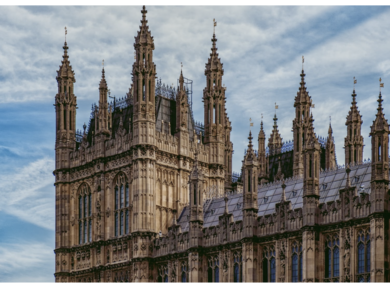Disclaimer: This blog post solely reflects the opinion of the authors and should not be taken to represent the general views of IPPR’s management/ editorial team or those of fellow authors.
In liberal democracies, the media is widely championed as an independent entity that exposes the truth, holds politicians accountable, and brings attention to humanitarian crises worldwide. Yet, research over the past few decades examining media activity has challenged this broadly held conception. The most influential work on this topic was done in 1988 by Edward S. Herman and Noam Chomsky in the publication of Manufacturing Consent: The Political Economy of the Mass Media, presenting a highly critical analysis of the US media, framing it as a propaganda machine utilised to perpetuate hegemony and maintain the status quo on behalf of special interests. To explain the true objectives of the US media, Herman and Chomsky formulate a “propaganda model”, which remains incredibly relevant to this day, providing prescient insight into the media’s inner workings following the turn of the millennium.
Firstly, we can examine instances in which the media has been credited for independently influencing policy. With respect to foreign policy, media coverage has often been cited for motivating Western powers to intervene on humanitarian grounds in Northern Iraq (1991) and the Bosnian civil war (1992-95). More in-depth analysis shows that such policy responses to media coverage are largely superficial; for example, news outlets fixated their attention on NATO forces airlifting small numbers of children out of conflict zones in Bosnia, a policy which Gowing (1994) describes as “cosmetic” and superficial. In the case of Northern Iraq, although US- intervention in the 1991 Kurdish crisis is often believed to have been driven by media pressure, Robinson (2013, p.2) argues that intervention was motivated by strategic concerns. The protection of Kurdish refugees was critical in maintaining stability in Southern Turkey, where around one million Kurds would otherwise flee. By creating “safe havens” for refugees within Iraq, the US drew Iraqi Kurds away from Turkey, thereby resolving a potential migrant crisis.
Most importantly, the mass media was largely instrumental in the emergence of the “humanitarian intervention” notion, whereby sovereignty is no longer sacrosanct when foreign states commit atrocities against their own citizens. Though the justifiability of such intervention is a fiercely debated topic, the pro-interventionist view is clearly favoured by hawkish foreign policy actors, having been used to justify wars in Kosovo, Iraq, and Syria, among others. Many critical theorists, Chomsky and Herman in particular, argue that news outlets skew foreign affairs reporting to align with pre-established ideological narratives justifying the foreign policy agenda of the US government.
Domestically, the US media is likewise largely complicit, if not instrumental, in pushing narratives that favour the political elite’s interests regarding wealth inequality, climate change, and criminal justice, among many other issues. Over the latter half of the 20th century, the media evolved into an instrument utilised to mobilise support for the special interests that dominate citizens’ activity. The abolition of the FCC Fairness Doctrine in 1987 only aggravated this issue, and sweeping deregulation under the Reagan administration further reduced the importance of non-commercial forms of media. Manufacturing Consent provides a robust explanation of the rationale behind the media favouring the political elite and conveys a propaganda model structured in five interrelated filters:
1 – Private Ownership and Profit Orientation
The first filter pertains to the corporate ownership of media outlets. The ultimate aim of mass-media, when acting as subsidiaries of larger conglomerates, is to maximize profit. Normative commitments of journalists and the moral obligation to discover and analyse facts in an objective manner come secondary to the goal of engineering profit. Although written in 1988, this filter is even more pertinent today as rapid globalisation continues to centralise media operations. Since the wave of sweeping neoliberal deregulation throughout the 1990s, the media industry has been concentrated within five transnational conglomerates: Comcast, Disney, AT&T, Viacom, and Fox. Together, these conglomerates control the world’s largest film studios, TV networks, book publishers, and news outlets. (Forbes 2020) Hence, the vast majority of media consumed in the Anglophone world are controlled by these select few groups, and coverage on issues such as climate change, inequality, and war are compromised in their objectivity due to having inherent biases stemming from their ownership. As mass-media outlets are foremost profit-based operations, they must cater to the financial interests of controlling investors.
2 – Demand for Advertising
This filter takes into account the fact that all major media outlets rely upon advertising revenue to finance operations and maintain profitability. Media outlets that fail to attract advertisers will not sustain operations due to the cost of funding media operations being considerably greater than the amount people are willing to pay in subscription fees and donations. Commercially non-viable forms of media, such as the working-class press, steadily declined in circulation as the twentieth century progressed, as they were unable to attain financial stability from advertising revenue. Hence, advertisers possess a “de facto licencing authority”, which they can selectively use to support news organisations and force them to cater to their political prejudices and desires. Coverage which interferes with the “buying mood” is undesirable (Herman and Chomsky, 2002, p.67), and advertisers seek programs that align with the spirit of consumerism. This serves as an explanation for the decline of working-class press throughout the twentieth century, as narratives promoting unionisation and class-consciousness are contrary to the interests of advertisers who intend to appeal to consumers.
3 – Sourcing of News
Furthermore, Herman and Chomsky assert that journalism cannot function as a counterweight to government power, as the mass media itself enjoys a symbiotic relationship with the government by “economic necessity, reciprocity and interest” (Herman and Chomsky, 2002, p.67). Here, the government can essentially “feed” information to news outlets on the condition that they are covered in a favourable way. For example, in covering foreign policy, state officials maintain a near-monopoly on foreign policy information, and in order to sustain a constant stream of news, the media must appeal to privileged sources of information. Incurring disfavour from particular sources will see noncompliant outlets starved from access to high-demand news material, resulting in the publication losing readers and, therefore, advertisers. Compliant journalists are invited to press briefings, handed out copies of speeches, and given exclusive access to information, whereas noncompliant journalists are starved of such privileges. To avoid this, news coverage is often editorially distorted to appease government interests.
4 – Flak
The fourth filter refers to the negative responses to media statements and programmes, traditionally in the form of letters, written complaints, and lawsuits. However, as political discourse is largely dictated by rhetoric in social media, the ease with which multitudes can criticise news programmes online has forced media outlets to formulate an editorial filter whereby certain stories can only be covered in a particular manner for fear of attracting unwanted criticism. Chomsky also suggests that “flak” can be engineered by powerful political groups who wish to prevent specific stories from being published, exemplified by recent practices known as “Astroturfing”, whereby private interest groups push narratives through the guise of unsolicited comments from the public.
5 – “Anti-Communism” (now anti-Terrorism)
Writing in the context of the cold war, Chomsky states “when anti-communist fervor is aroused, the demand for serious evidence in support of claims of “communist” abuses is suspended, and charlatans can thrive as evidential sources” (Herman and Chomsky, 2002, p.78). Communism is presented in the media as a universal evil that must be feared and combated at all costs. Since the end of the cold war, this purpose has largely been replaced by “anti-Terrorism”, which serves an identical purpose as a potent mechanism of social control limiting the variation of information reported by news media. Therefore, the media cannot afford to cover events that may be interpreted as overly favourable to “communists” or ”terrorists”, as doing so will incite backlash and harm the outlet’s commercial interests.
Discussion
Taking these filters into account, despite the media being seen as the purveyor of truth, all news is conducted within an inherently biased framework in favour of those in power. For example, with respect to foreign affairs, we can observe how the US media chooses to depict victims of political violence. Chomsky and Herman emphasise the concept of “worthy” and “unworthy” victims. For instance, Polish priest Jerzy Popieluszko, murdered by the communist Polish government in 1984, received over a hundred times as much coverage as the murder of Archbishop Oscar Romero by the US-backed dictatorship in El Salvador. In fact, Popieluszko received more coverage than the hundreds of religious victims killed in US-supported states, even though eight of these victims were American citizens (Herman and Chomsky, 2002, p.88). Here, the media influences the public to be enraged about atrocities committed in Soviet client states but blind to identical crimes committed within the US sphere of influence.
A similar trend can be observed stretching from the 1990s-present in how the Kurds have been depicted by the US media. The revised edition of Manufacturing Consent uses the treatment of Kurds to exemplify how the US media deliberately ignored the Turkish oppression of Kurds, while heavily condemning Iraqi oppression of Kurds. The frequency of the word “Genocide” is useful in analysing media discourse due to its strong connotations, and Chomsky and Herman examined its usage in the largest US media outlets when describing the treatment of Kurds in Turkey and Iraq. Although Turkey’s treatment of its Kurds was “in no way more murderous than Iraq’s treatment of Iraqi Kurds” (Herman and Chomsky, 2002, p.19), the use of the term “genocide” was almost always applied when referring to the repressive actions of Iraq’s government, whereas Turkish repression of Kurds, when addressed, was done so in more equivocal terms. The table below, using data from Herman and Chomsky’s research in the 2002 edition of Manufacturing Consent, shows that from 1990-1999, the term “genocide” was used 132 times by major print publications to describe Iraq’s oppression of Kurds, compared to 14 times when describing Turkey’s treatment of Kurds (ibid).
Since the 1980s, wealth has become increasingly concentrated among the elite, where the wealthiest 1% of individuals own 40% of the nation’s wealth in the United States. Since mainstream media outlets are either part of large conglomerates, Herman and Chomsky argue that information presented to the public will be biased in favour of commercial profit. Hence, well-funded media outlets are privy to corporate interests; the military establishment must be protected from a public that would rather see such resources be diverted to social welfare programmes (Pocan, 2020), and the current regressive tax system must be protected from a majority who wish to implement a more progressive tax rate (Sheffield, 2021). For example, the top five US oil companies have spent at least 3.6 billion USD on advertising and public relations campaigns, with their wealth providing them with a de facto licencing authority on media coverage (Boykoff, 2014). This may explain why US media outlets give near-equal balance to those who deny the reality of climate change (ibid), contrary to the overwhelming scientific consensus on this subject.
Furthermore, it is also important to address the rise of “alternative” news sources, perhaps the most notorious of which is Alex Jones’ Infowars. Neglecting source-based reporting almost entirely, such outlets rely on conspiratorial conjecture, appealing to a very specific audience who are mistrustful of mainstream sources but are drawn to even more harmful, far-right content. Despite being unappealing for mainstream advertisers, Infowars compensates for this potential lost revenue by selling paraphernalia, clothing, and pseudoscientific health supplements, which functions in place of advertising as their primary source of income. While working in a different way to mainstream outlets, the profit-orientation of news media remains pertinent, with the end goal for such outlets being profit. In the case of Infowars, their pseudoscience and conspiracy theories function largely as a vehicle through which they can sell products such as “5G Kills” T-Shirts and “Toxin Filtration Systems” for tap water.
Screenshot from the Infowars online store
Conclusion
Therefore, media outlets cannot function in an independent and objective manner when their survival is contingent on their ability to generate income. As Aday writes in the Oxford Handbook of Political Communication, “the press-state power dynamic clearly favours political elites” (2018, p.326). Through the powerful instrument of the mass media, governments and corporations “manufacture consent” to enact policies which benefit the political establishment and the wealthiest echelons of society. As system-supportive propaganda is deeply entrenched in media institutions, there is no simple solution to remedy the media’s inherent biases and political inclinations. Potential solutions involve reducing the necessity for media outlets to make profit, either through government action by subsidizing news or breaking up large corporations, which nevertheless encounters the major issue of the government possessing control over media narratives. This ties into Chomsky’s radical leftist political philosophy, arguing that the very nature of capitalist democracy is unsustainable, as the drive for profit dominates over truth-seeking in the corporate media. Written in Manufacturing Consent’s final paragraph, Chomsky states that “The organization and self-education of groups in the community and workplace, and their networking and activism, continue to be fundamental elements in steps towards the democratization of our social life and any meaningful social change. Only to the extent that such developments succeed can we hope to see a media that are free and independent.”
Bibliography
Aday, S., 2014. The US Media, Foreign Policy, and Public Support for War. Oxford Handbooks Online.
Boykoff, J., 2014. Journalistic Balance as Global Warming Bias. [online] FAIR. Available at:







